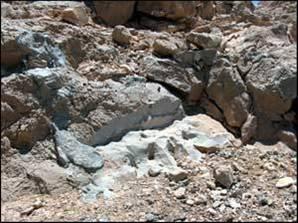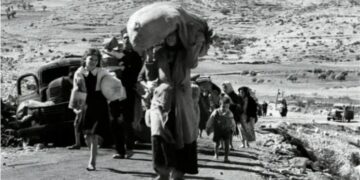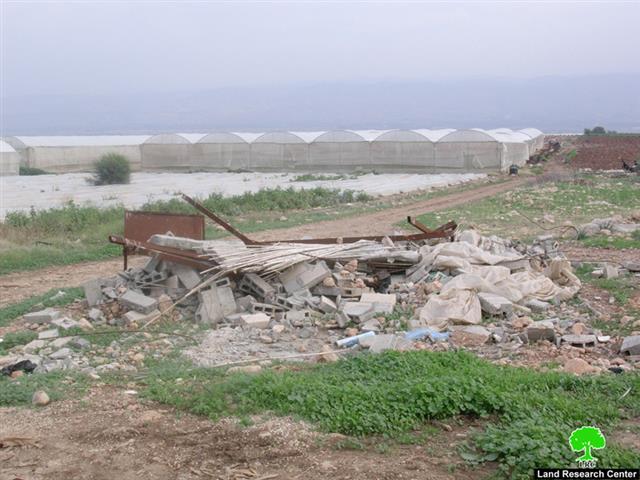Introduction:
A new study revealed that Israel has been dumping more than 50% of its nuclear and chemical waste (estimated weight of 3 million tons) in Palestinian lands especially in the southern parts of the West Bank. The study was researched by Mr. Jaber Al Tmaizy (the Coordinator of the Farmer’s Union in the City of Hebron) who indicated that the buried waste is causing slow death to Palestinians via spreading dangerous diseases. The waste is also causing a great damage to the environment as it emits poisonous gases that are internationally forbidden.
Rocks that has chemical materials and traces
The study also revealed that Israeli courts have ordered the shut down of Israeli factories in the cities of Natania and Kfar Saba due to the danger it forms on both humans and the environment. However, these shutdown factories have relocated to confiscated Palestinian lands in the West Bank especially around the cities of Tulkarem, Salfeet and Hebron. These factories have caused the spread cancer causing elements as well as the spread of sewage water and harmful by-products into Palestinian cities and villages.
According to Mr. Tmaizi, the relocation of these factories was not done without prior planning; according to him, the relocation to border cities is yet another ring in the chain of conspiring against the Palestinian people in an effort to displace them at any cost.
The weapons used by the Israeli occupation are filled with
poisonous gases and dangerous radiation
Dr. Mahmoud Sa’adeh, Vice President of the Middle East Desk at the International Doctors for Protection from Nuclear War (IDPNW) and the head of the Palestine Delegation at the organization, indicated that Israel has buried thousands of tons of chemical and radio active materials in Palestinian lands. He also declared that Israel does not abide by the letter of the law of burial of nuclear waste as burial must take place at a depth no less than 50 meters. Israel carries out its burial of nuclear waste at much lower depth and without consultation or informing the Palestinian side of its operations. Dr. Sa’adeh also alerted to the negative health effects of the arsenic and methane gases emitted from such nuclear waste. He informed the Land Research Center’s field researcher that:
For the past two years Israel has been working to change the Palestinian genes through inserting a virus to its DNA with the aim of creating a lazy and idiotic public that would be controlled in a much easier manner.
He provided the following table that lists all of the cancer cases in the towns of south Hebron Governorates (Adh Dhahiriya, Yatta and As Samu’) throughout the years:
|
Year |
No. of Cancer Cases |
|
1960 – 1970 |
1 case |
|
1970 – 1980 |
1 case |
|
1985 – 1995 |
8 cases |
|
1995 – 2007 |
415 cases |
Four more cancer cases were identified in the town of Adh Dhahiriya in the last week of August 2008. The huge increase in cancer cases was coupled with an increase in the incidents of infertility and sexual impotence as well as in congenital malformations of embryos, newborn and a high abortion rate.
Dr. Sa’ada also indicated the presence of a rare case of heart cancer which only 5 out of 100 million people worldwide suffer from it. A 13-years old boy from Yatta (named Fahmi Ibraheem) has this rare type of diseases despite the fact that it only attacks people who are 50 years old or above. Another rare cancer is the eye cancer. A 5-year old boy (named Bilal Hanatsheh) from the village of Al Burj was diagnosed as having this type of cancer which led to the removal of both eyes when cancer spread to both of them one after the other. That is in addition to a case of bone cancer that was registered in south Hebron. The young man who had that type of cancer died two months ago.
The International Doctors for Protection from Nuclear War (IDPNW) carried out an air quality test in 2002 for the region of South Hebron. The aim was to gain knowledge about the percentages of Uranium 238, Thorium-232, Potassium 40 and Cesium 137 in the air. The results of the testing came as follows:
|
Region |
U 238 |
TH 232 |
K 40 |
CS 137 |
TOTAL |
|
Beit Al Rush |
64.9 |
127.5 |
133.8 |
30.2 |
356.4 |
|
Jabal Abu Ashara |
40.8 |
53.5 |
349 |
24.2 |
467.5 |
|
Ramadien Way |
100.5 |
45.1 |
317.1 |
12.4 |
475.1 |
|
Wadi Al Khalil |
237 |
130.7 |
819.1 |
24 |
1210.8 |
|
As Samu’ north |
88.5 |
124.8 |
403.5 |
15.3 |
632.1 |
|
Southeast Yatta |
105.5 |
152.7 |
396.5 |
11 |
665.5 |
|
Yatta – Center |
51.6 |
53 |
502.3 |
10 |
616.9 |
|
South of Yatta |
44.7 |
68.4 |
446.8 |
9 |
1184.5 |
|
Al Fawwar |
62 |
70 |
521 |
2.7 |
655.7 |
|
Percentages |
795.5 |
825.7 |
3889.1 |
138.8 |
|
In terms of the air pollution in south Hebron Governorate caused by the radiation emitting from the nuclear dumpsites and by the usage of forbidden weaponry by the IDF, the IDPNW has indicating the following:
|
Area |
The percentage of CS 137 in the air |
The percentage of natural CS 137 in the open air |
|
Beit Ummar |
15 Picril/kg |
0 |
|
Halhul |
13.2 Picril/kg |
0 |
|
Al Fawwar |
9.2 Picril/kg |
0 |
|
Yatta |
30.1 Picril/kg |
0 |
|
Adh Dhahiriya |
11.3 Picril/kg |
0 |
The table is represented in the following graph:
A comparison was also done between the 2002 and 2007 figures regarding the presence of Cesium 137 as reflected in the following table:
|
Region |
CS 137 in 2002 |
CS 137 in 2007 |
Natural percentage |
|
Adh Dhahiriya |
24 Picril/kg |
11.3 Picril/kg |
0 |
|
Yatta |
9 Picril/kg |
36.1 Picril/kg |
0 |
|
Fawwar |
2.7 Picril/kg |
9.2 Picril/kg |
0 |
|
Halhul |
0 |
13.2 Picril/kg |
0 |
|
Beit Ummar |
0 |
15 Picril/kg |
0 |
Soil analysis was also performed to determine the presence (or lack thereof) of the Uranium elements in it. The following table illustrates the findings:
|
City |
Uranium testing Results |
Normal Uranium Presence |
|
Halhul |
105 Picril/kg |
30 Picril/kg |
|
Beit Ummar |
98 Picril/kg |
30 Picril/kg |
The study conducted by the IDPNW pointed out the environmental damage caused by the nuclear emissions as it noted the extinction of some types of reptiles and plants that camels and sheep depended on as the main source of their feed in the southern parts of Palestine as well as in the southern areas of Jordan. The study also noted the appearance of new types of yellow scorpions and cockroaches which provides creditability to the studies done by the Japanese on the nuclear effects of the obliteration of the cities of Nagasaki and Hiroshima. Such studies found that the only creatures that stayed alive after the two nuclear bombings were the scorpions and cockroaches.
As for the presence of the lethal element of CS 137, it was found in high percentages in the city of Yatta and its environs. Its presence has increased from a mere 9 to 11 Picril/kg in the year 2002 to the dangerous level of 36 to 39 Picril/kg in the year 2007. This fact has led the researchers to concentrate their efforts on the Yatta area. The thorough testing of Yatta produced the following table:
|
Regions of Yatta |
Percentage of Affected Population |
|
North of Yatta |
18% |
|
East |
11% |
|
West |
14% |
|
South |
39% |
|
Center |
18% |
The results of the testing are also reflected in the following graph:
Documents collected from the different clinics, hospitals and private observations have indicated that the residents of the southern parts of Hebron Governorate are more Susceptible to diseases associated with nuclear radiations such as repetitive abortions and malformation of fetuses in addition to the increase in the number of cancer cases and infertility. The unusual increase in the number of abnormalities led the IDPNW research team to carryout an extensive house-to-house study of the area of Yatta between February and July 2007. The study tested a population of around 50,000 Palestinians and found that there are 368 different cases of cancer in accordance with the following table:
|
Type of cancer |
Percentage |
|
Reproductive system |
36.13% |
|
Breast cancer |
14.77% |
|
Lung cancer |
13.63% |
|
Endocrine glands |
9.09% |
|
Bone |
5.52% |
|
Kidney |
7.38% |
|
Nerves |
5.11% |
|
Chest |
4.54% |
|
Stomach |
3.97% |
|
Skin |
3.97% |
|
Liver |
3.40% |
Most of the cancer patients were between 16 and 60 years old 15 of which died during the time period of the study. It is worth noting here that the studied cases did not have any prior family history in cancer.
Photo 3: A map showing the geographical effects of the radiation emitted from
Dimona to the southern parts of the West Bank.


















